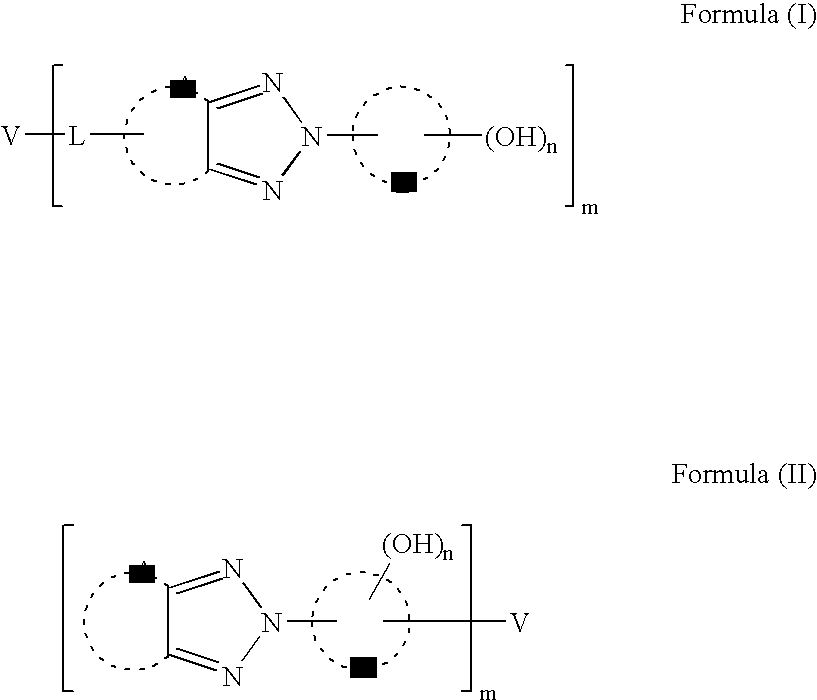Specific dye compound, optical information recording medium comprising specific dye, and information recording method using this optical information recording medium
a technology of optical information and dye compound, which is applied instruments, and can not be said that the dvd-r has a level of recording capacity adequate to meet future demands, and can be used in the direction of optical recording/reproducing/erasing methods, etc., to achieve the effect of high density, superior recording properties and satisfactory strength and quality
- Summary
- Abstract
- Description
- Claims
- Application Information
AI Technical Summary
Benefits of technology
Problems solved by technology
Method used
Image
Examples
synthesis example 1
Synthesis of Compound 1 Exemplified as Recording Dye
[0098]0.33 g of 5-carboxy-2-(2-hydroxy-3-tert-butyl-5-methylphenyl)-2H-benzotriazole was dissolved in 20 ml of methylene chloride. 0.1 ml of oxazolyl chloride was added to the resultant solution. The resulting solution was stirred at room temperature for 1 hour, and then 54 mg of phenylenediamine and 0.3 ml of triethylamine were added to the solution. The resultant solution was stirred for 2 hours, and then water was added to the solution, so as to extract the organic material with methylene chloride. This methylene chloride solution was dried with sodium sulfate and then the solvent of the solution was distilled off. The remaining solid was washed with ethyl acetate and 0.3 g of compound 1 was obtained.
[0099]λmax=361 nm (CHCl3) Mass (posi)=722
synthesis example 2
Synthesis of Compound 21 Exemplified as Recording Dye
[0100]Five milliliter of an aqueous solution in which 0.5 g of sodium carbonate was dissolved in 5 ml of toluene was added to 0.5 g of 4-bromo-6-methyl-2-(2-hydroxy-3-tert-butyl-5-methylphenyl)-2H-benzotriazol, 0.18 g of pinacol ester of benzene-1,3,5-triboric acid, and 15 mg of palladium acetate. 27 mg of tri-tert-butylphosphine was added to the resultant solution while the solution was stirred under nitrogen flow. The resultant solution was stirred at 80° C. for 10 hours, and then 1 N hydrochloric acid was added thereto. After the resultant mixture separated into two phases, the aqueous phase was removed. The remaining organic phase was dried with sodium sulfate and the solvent in the organic phase was distilled off. The remaining solid was purified with silica gel chromatography and 0.3 g of compound 21 was obtained.
[0101]λmax=349 nm (CHCl3) Mass (posi)=958
synthesis example 3
Synthesis of Compound 40 Exemplified as Recording Dye
[0102]Five milliliter of an aqueous solution in which 0.5 g of sodium carbonate was dissolved in 5 ml of toluene was added to 0.6 g of pinacol ester of 5-tert-butyl-3-(5-trifluoromethyl-2H-benzotriazolyl)-2-hydroxyphenylboric acid, 0.18 g of 1,3,5-triiodobenzene and 15 mg of palladium acetate. 27 mg of tri-tert-butylphosphine was added to the resultant solution while the solution was stirred under nitrogen flow. The resultant solution was stirred at 80° C. for 10 hours, and then 1 N hydrochloric acid was added thereto. After the resultant mixture separated into two phases, the aqueous phase was removed. The remaining organic phase was dried with sodium sulfate and the solvent in the organic phase was distilled off. The remaining solid was purified with silica gel chromatography and 0.2 g of compound 40 was obtained.
[0103]λmax=359 nm (CHCl3) Mass (posi)=1078
[0104]Synthesis Examples of the above-mentioned recording dyes (dye compoun...
PUM
| Property | Measurement | Unit |
|---|---|---|
| wavelength | aaaaa | aaaaa |
| wavelength | aaaaa | aaaaa |
| wavelength | aaaaa | aaaaa |
Abstract
Description
Claims
Application Information
 Login to View More
Login to View More - R&D
- Intellectual Property
- Life Sciences
- Materials
- Tech Scout
- Unparalleled Data Quality
- Higher Quality Content
- 60% Fewer Hallucinations
Browse by: Latest US Patents, China's latest patents, Technical Efficacy Thesaurus, Application Domain, Technology Topic, Popular Technical Reports.
© 2025 PatSnap. All rights reserved.Legal|Privacy policy|Modern Slavery Act Transparency Statement|Sitemap|About US| Contact US: help@patsnap.com



